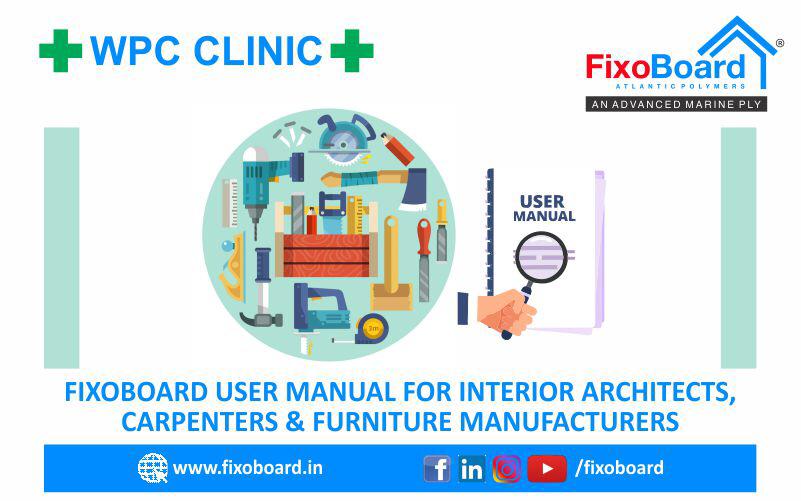FixoBoard can be easily machined using ordinary tools used for processing metal or wood. However, the following precautions need to be taken. Avoid sharp edges and deep notches which can cause stresses leading to early breakage.
Cooling is not necessary under normal conditions if the cutting edges are kept sharp and the processing heat is dissipated by quickly removing the shavings. However, compressed air, water or cooling liquid is suitable if used in accordance with the existing safety instructions.
To obtain smooth or glossy surfaces, finishing with felt buffing wheels or tapes is recommended.
Cutting/Sawing:

FixoBoard up to 3 mm thickness can be cut with a knife or blade. Thicker sheets can be cut with hand saw or circular saw. High saw speeds up to 3000 RPM with tooth pitch of 5 to 10 mm are used depending on board thickness. For circular saws, it is commonly recommended to use tooth geometry alternating between flat tooth, trapezoidal tooth and rigid metal. Always fasten the sheet and avoid vibrations during cutting to achieve clean cutting edges.
Drilling:

FixoBoard can be drilled with conventional, high helix, high speed steel carbide tipped metal bits. Cutting edges must be kept sharp to prevent poor surface finish and undersized holes. Cutting and feeding speed depends on depth of bores, the thicker the sheet the lower the speed.
Routing:

Stationary or hand routers can be used for slotting, beveling, rabbeting, rounding edges and trimming. Best cutting results are obtained with carbide tipped router bits.
Milling:

FixoBoard can be milled with milling tool that has allowance to accommodate smoother removal of chips. High forward feed along with moderate cutting speed and deep cuts will lead to good results.
Turning:

FixoBoard can be worked by turning with a point of turning tool rounded to 0.50 mm radius to avoid linear marks on cutting surfaces. During precision turning, lower cut (2 mm) and faster feeding should be used to prevent sheet breakage.
Cutting & Punching:

FixoBoard can be easily cut by shearing up to 3 mm thickness. In case any deformity, rougher cut surface or fracturing is noticed, it is primarily because of sheet temperature. FixoBoard, a thermoplastic material, tends to acquire brittleness at lower temperatures. Therefore, pre-heat the sheet material to 95- 131′ F, before shearing. Die cutting by “Steel rule dies” is a common practice. ldeally it is 25 mm wide strip steel, thickness 0.35 – 1 mm, with one edge pre-shaped as knife. Bevel may be used depending on cut requirements with one side or both side honing. The bevel should be 5 or 6 mm in length.
BONDING:
FixoBoard can be bonded both to itself and other materials. Adhesive types must be chosen according to bonding requirements.
Edge bonding and joining parts of sheet materials:

PVC/WPC solvents such as Tetrahydrofuran, Methyl Ethyl Ketone or Cyclohexanone can be used. Solvents must be fresh and effective.
Bonding to nonporous materials such as other plastics/metals:

Polyurethane or other synthetic rubber-based adhesives are recommended. Solvent-free two-part Polyurethane adhesive can also be used. Adhesives must be applied to both faces; quantity approximately 150 g/m. A parallel bead of adhesive is often preferred because it offers evaporation of solvent providing faster cure.
Bonding with flexible FixoBoard sheets:
Only plasticizer-resistant type adhesives should be used.
Bonding porous material such as papers, Textiles, Fabrics or Wood:
Contact adhesive with solvent can be used. Follow same directions for application as for non-porous bonding. Pressure sensitive tape can be used for stress free and less demanding applications.
PAINTING & COATING:

FixoBoard are easy to paint with rigid PVC compatible paints. These can be Vinyl, Acrylic lacquers, or two-part Polyurethane based paints. Sheets must be dry, clean and oil/grease free. Cloth soaked in Isopropyl alcohol is recommended for surface cleaning. Screen printing should be allowed to air dry instead of heat drying. Temperatures in excess of 149° F may cause sheet warping or blowing.
Fixing recommendations for FixoBoard Integral Foam sheets:
Linear thermal expansion for the material is to be considered during mounting or installation of FixoBoard. This, as in all thermo-plastic materials, is necessary to avoid Warping, Bulging or Stress induction in the sheet.
| Temperature Change °F | 4’long | 6′ long | 8′ long | 10′ long |
| 41°F | 0.41 | 0.69 | 0.86 | 1.15 |
| 50°F | 0.93 | 1.39 | 1.86 | 2.20 |
| 68°F | 1.80 | 2.75 | 3.60 | 4.60 |
| 86°F | 2.65 | 4.15 | 5.50 | 7.05 |
| 104°F | 3.75 | 5.60 | 7.50 | 9.40 |
For any queries related to our products you can mail on info@fixoboard.com or WhatsApp us on +91 9930349421/ +91 9930349472
Like Us / Follow Us :
Facebook : https://www.facebook.com/fixoboardPVC
Instagram : https://www.instagram.com/fixoboard
LinkedIn : https://www.linkedin.com/company/fixoboard/

